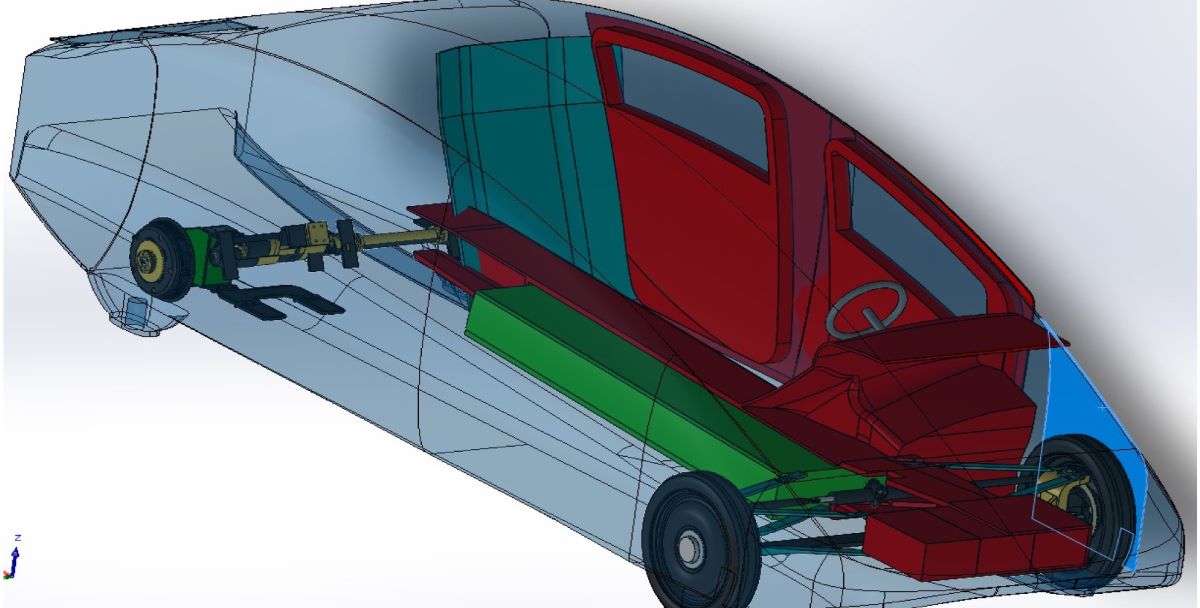A research team at Italy’s University of Bologna carried out crash simulations to qualify a novel solar-powered 4-seater car that will participate in the 3,000 km Bridgestone World Solar Challenge (BWSC) across the Australian continent.
The electric solar vehicle, named Emilia 5, is a Cruiser class entry in the 2025 BWSC event. The Cruiser class is one of the biennial event’s three solar car categories that the organizers created to encourage concept cars with “innovative, sustainable, and potentially practical features that could find their way into real-world design”.
Emilia 5 measures 4,500 mm x 1,510 mm x 1,230 mm and weighs just 350 kg. The engine has 120 km/h maximum velocity. It is powered by solar PV panels from Italian module manufacturer Solbian, which uses Maxeon cells. The car's chassis is made of carbon fiber reinforced plastic (CFRP).
It is the fifth model made by the Italian Onda Solare team, and the third in collaboration with the University of Bologna. “The team began competing in 2003 with its first vehicle, which was a solar bicycle. The University of Bologna joined in 2013 with Emelia 3, a Challenger Class vehicle. The next car, Emelia 4, was a Cruiser Class vehicle. It won the 2018 American Solar Challenge and the 2021 iLumen European Solar Challenge,” research leader Giangiacomo Minak told pv magazine.
Minak noted that Emilia 5 has some of the same elements as Emilia 4, such as the powertrain, which the team designed itself. “New is the use of recycled carbon fiber material in the parts used in the front and rear of the vehicle. We also used recycled molds. The interior is more spacious and comfortable for four passengers. The door openings are designed to accommodate physically challenged passengers,” said Minak.
“We additionally modified the design for strong crosswinds. Despite changes, the aerodynamics are going to be at least as good as Emelia 4. The color will be Ferrari red,” said Minak, adding that the group recently received funding from the Italian National Center for Sustainable Mobility (MOST), which is backed by the NextGenerationEU program.
The crash simulations involved three mandatory tests: a frontal impact test, a side impact test, and the rollover impact test. The team used Ansys LS-Dyna 2023 R1 software and LS-Dyna R13. The latter was used to generate seat belts and to measure intrusion inside the cockpit.
Popular content
Referring to the vehicle’s aerodynamics, which allows it to reach velocities comparable to those of road vehicles, the researchers asserted that it is not unreasonable that it could be in a situation comparable to the crash tests similar to those to which small road vehicles such as city cars are subjected.
A great deal of computational resources for the impact simulations were required because almost the entire vehicle, including seats, seatbelts, and sled test, had to be verified. “Crash simulations on composite materials often only concern simple components such as plates submitted to bending impact, low-velocity impact, barriers subjected to bullet impact or tubes of various section subjected to axial impact,” explained the team.
Another challenge in the numerical modeling of CFRP components is that they have “anisotropy”, mechanical properties that change depending on the orientation of the loads.
“Through three crash test simulations utilizing Finite Element Method (FEM) software, as mandated by the competition guidelines, the vehicle demonstrated robust resistance to deformation,” concluded the team.
The team presented its findings in the study “Crashworthiness investigation on a Carbon Fiber Reinforced Plastic solar vehicle,” published in Composite Structures.
With this set of tests completed, the Emilia 5 design will progress towards competing in the next BWSC. In the meantime, Minak said, the Italian team is preparing for the eight-day Sasol Solar Challenge across South Africa in mid-September.

Image: Onda Solare
This content is protected by copyright and may not be reused. If you want to cooperate with us and would like to reuse some of our content, please contact: editors@pv-magazine.com.


By submitting this form you agree to pv magazine using your data for the purposes of publishing your comment.
Your personal data will only be disclosed or otherwise transmitted to third parties for the purposes of spam filtering or if this is necessary for technical maintenance of the website. Any other transfer to third parties will not take place unless this is justified on the basis of applicable data protection regulations or if pv magazine is legally obliged to do so.
You may revoke this consent at any time with effect for the future, in which case your personal data will be deleted immediately. Otherwise, your data will be deleted if pv magazine has processed your request or the purpose of data storage is fulfilled.
Further information on data privacy can be found in our Data Protection Policy.